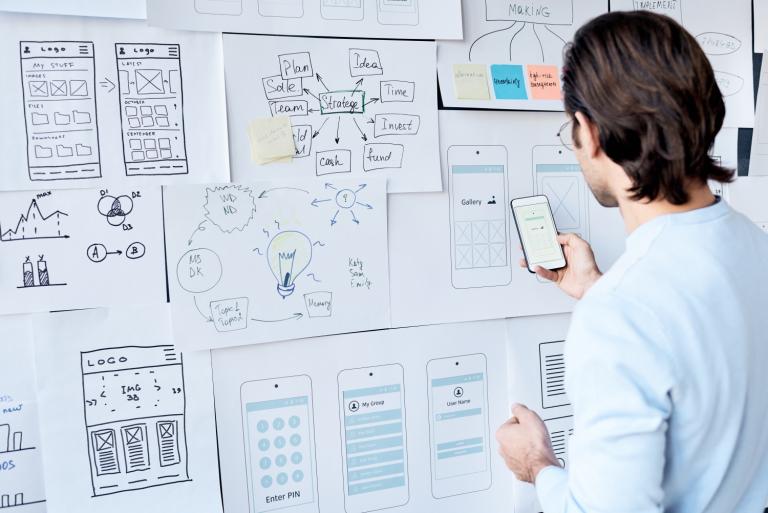If you’ve heard the term user-centred design (UCD), but you’re not sure what it means, read on. In this blog post, we’ll look at everything you need to know about user-centred design. We’ll also look at the types of work this design approach is most applicable for.
What is user-centred design?
User-centred design is an iterative process where the focus is on the needs of the users. During a user-centred design project, research and various techniques are used to create a product that’s easy for users to adopt and access. Developers will use investigative methods, such as surveys or interviews, where they’ll work to understand the user’s needs.
The phases of user-centred design
For anyone using this approach in a project, there are generally four phases you’ll follow.
- Firstly, they’ll work towards understanding the context of why the user may require the software.
- Following that, it will be time to specify the user requirements.
- Thirdly they’ll move to the design phase, where the team will begin to develop solutions.
- Finally, they’ll end with an evaluation phase, where they can judge their work against the users’ needs.
This will then loop all the way back to the first phase. Developers will then keep going through these four phases. This will ensure they finally create a solution that fulfils all the expectations and requirements of the users.
Making software user-friendly
If you have commissioned a software project to be built, your developers will aim to make your software project user-friendly. When it comes to deciding whether your software is user-friendly, there are certain signs your developer will look out for. Once the product is live or a prototype had been created you will start to receive feedback. If negative feedback is received, your developer will look for some issues in this area. This feedback will be a great way to guide them in your product’s development in the future.
Features can also be built into your software project, to collect or ask for feedback. This allows your development company to quickly ascertain users’ satisfaction levels and fix any issues that may be occurring. Your development company may also interview your users or hold focus groups. This will enable them to learn more about user expectations and requirements for your software.
Check with your developer
Your developer should design your software, to make it accessible to as many users as possible. Individuals shouldn’t need extensive training to be able to use your software. Ideally, they should be able to download it and use it within minutes. Ensure your developer has made it intuitive and not too complex for the average user to benefit from using. If you’re offering trials to attract customers remember to track, the conversion rates. If these rates are too low, you’ll need to investigate the low retention rate after the trial ends.
Improving the user experience
At the heart of the user-centred design approach, is the goal of improving user experience. Once you get to know your audience better, you can work with your developer to improve your offerings. Your user experience is made up of a wide range of elements, including ease of use, style, workflow, and familiarity. By improving the presentation and functionality of your software, you’ll find that you can offer a more user-friendly experience. We always recommend looking at your competitors to see what features and design elements are making them more successful than you. Take inspiration from their software and implement the key features from their work into yours.
Listen to your users
User-centred design is focused on listening to users. If you don’t take the time to understand their expectations, you will never succeed with this approach. We encourage you to regularly take note of their comments and feedback and ask your developer to implement any suggestions made. Finally, as part of the user experience, you’ll also want to focus on the look and feel of your software. It’s not just about having an effective tool, you’ll also want to offer something that is pleasing to look at.
Adopting user-centred design?
Almost any business application could benefit from using user-centred design. But you’ll need to ensure you have the time and budget to dedicate the resources to listen to your users. Software and hardware design and development projects often take a user-centred approach, and most software companies find it to be a very effective way of working. Technology companies regularly use this approach to create operational solutions that are user-friendly and meet the demands of their audience.
Businesses or government organisations also often use this to ensure their products are accessible to a wider audience. A team of professional software developers will be happy to take this approach when working with you and can guide you through working in this manner during the development of your business software project. You can also use market research companies to assist with the research phase to help you understand your customers further.
Final Thoughts
There are many great benefits of adopting the user-centred design approach, which is why so many companies use it. It will help you to understand your users’ expectations fully. The iterative way of working within this approach will enable your developer to make changes throughout the development process. While it may seem like it could take up more time and resources, many companies find that this is not the case. Correcting issues early on in the design process saves valuable resources.
BSPOKE Software regularly takes a user-centred design approach when creating custom software for their clients. For business software that is tailored to you and your customer’s needs, call today to set up a free consultation!

